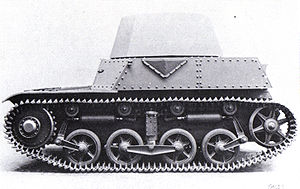AMC 34
| Renault AMR 34 | |
|---|---|

AMC 34 prototype |
|
| General properties | |
| crew | 2–3 (commander, driver, partly gunner) |
| length | 3.98 m |
| width | 2.07 m |
| height | variable depending on the type of tower (bath height 1.55 m) |
| Dimensions | 9.7 tons |
| Armor and armament | |
| Armor | 20 mm |
| Main armament | 47 mm anti-tank gun |
| agility | |
| drive | 7.125 liter V-8 120 hp engine |
| suspension | vertically sprung bogies and two horizontally sprung wheel sets on each side. |
| Top speed | 40 km / h |
| Power / weight | PS / ton |
| Range | 200 km |
The AMC-34 was a French tank originally built for the cavalry units of the French army. Production was stopped shortly after the start of production. The few tanks built were already decommissioned at the time of the western campaign .
development
On December 24, 1931, the French army, extremely concerned about the rapid build-up of the Red Army , drafted a plan for the mechanization of the cavalry. This saw the development of different types of Automitrailleuse (MG-Wagen), including the Automitrailleuse AMC , a lightly armored (9 tons) but fast vehicle with a cruising speed of 30 km / h. It was heavily armed with a 47 mm cannon for use against enemy tanks. The plan was approved by the French Ministry of Defense on December 9, 1932.
The decision to build such a vehicle was taken before 1931 and the designer Louis Renault was commissioned to build a prototype. Development work began in the autumn of the same year. Renault rejected the proposal to use welded steel plates for reasons of cost, as this would have resulted in the hiring of additional professional welders . Nevertheless, a welded prototype of a Char Rapide (French for fast tank ), which could also be used as an alternative to the AMR-33 , was developed in parallel and without an order from Renault-VO . When this vehicle was completed in 1932, Renault was initially enthusiastic about the design, but after much deliberation decided not to accept the welded model and ordered the riveted version. This decision was made too quickly and caused a complete overhaul of the project. The result was the Renault YR. After testing by the Technique de la Cavalerie section , the prototype was improved by installing a larger fuel tank, a stronger clutch and a stronger gearbox. On March 9, 1934, the order for a pilot series of the AMC-34 was awarded.
description
The AMC-34 was a small vehicle that was 3.98 m long and 2.07 m wide. The suspension of the prototype was identical to that of the AMR-33. The vehicles produced were equipped with a central bogie with a vertical spring, a variant as originally intended for the AMR-35. Two more wheels at the front and rear were equipped with hydraulically damped suspension. It was powered by a 7.125 liter V8 engine with an output of 120 hp, sufficient for a top speed of 40 km / h. With the 220 liter fuel tank, a distance of 200 kilometers could be achieved. The vehicle was front-wheel drive. The engine was in the right front area, the driver sat next to it on the left. The thickness of the armor was a maximum of 20 mm.
history
1934 plan
The order was canceled even before the production of the first series vehicle, as it was decided on June 26, 1934 as part of the 1934 plan (this was to increase production numbers and improve the quality of French tank production), the requirements for the AMC 34 to change. Its armor turned out to be too weak against the fire from anti-tank rifles and should have been reinforced. However, the chassis was not able to carry the increased weight. For this reason, the model was redesigned to the AMC 35 .
France and Morocco
To that France believed not waive the twelve have been completed-built vehicles the previous series, these were put into service and the fourth in January 1936 Cuirassiers - Regiment allocated. Originally equipped with the machine gun turret of the Renault FT , they were later converted to the turret of the APX1 with an SA34 47 mm cannon, as was also used in the Char D2 .
In 1937 the growing production of modern tanks made it possible to hand over the vehicles to the colonial troops in Morocco. The vehicles had ER-28 shortwave radio (the equipment regulations stipulated a radio device for each vehicle), as well as improved protection of the fuel tank on the rear. The grille was bulletproof on the rear engine cover.
At the beginning of 1940 the AMC-34 were replaced by the Hotchkiss H-39 . Since then, the vehicles have only been used for training. They were not on the armistice control lists, so they either had been scrapped in the summer of 1940 or had been hidden.
Belgian version
A mechanization program was launched in the Belgian cavalry in 1935. It was planned to equip all six cavalry regiments with a squadron of twelve tanks each: eight light tankets T-15 and four tanks. For the armored equipment, 25 chassis from Renault and 25 towers from APX were ordered. Renault had not even started series production of the AMC 34 because it was not intended for acceptance by the French army. However, the turrets were delivered by APX and armed with the SA35 47mm cannon and the 13.2mm Hotchkiss machine gun . At first the towers were intended for bunkered coastal batteries and were partially built accordingly. However, after Belgium received twelve of the AMC 35 type , the remaining towers were installed on this chassis.